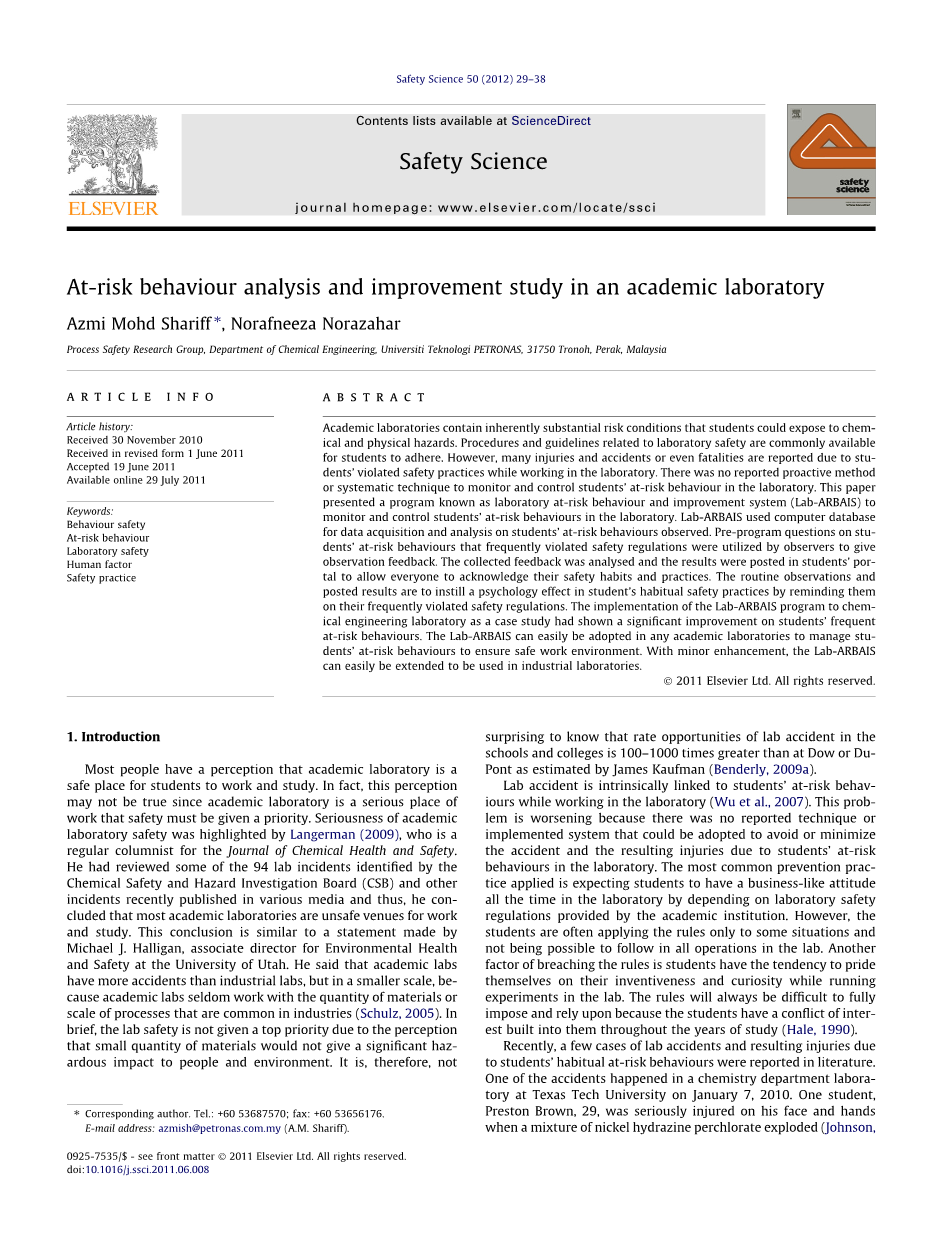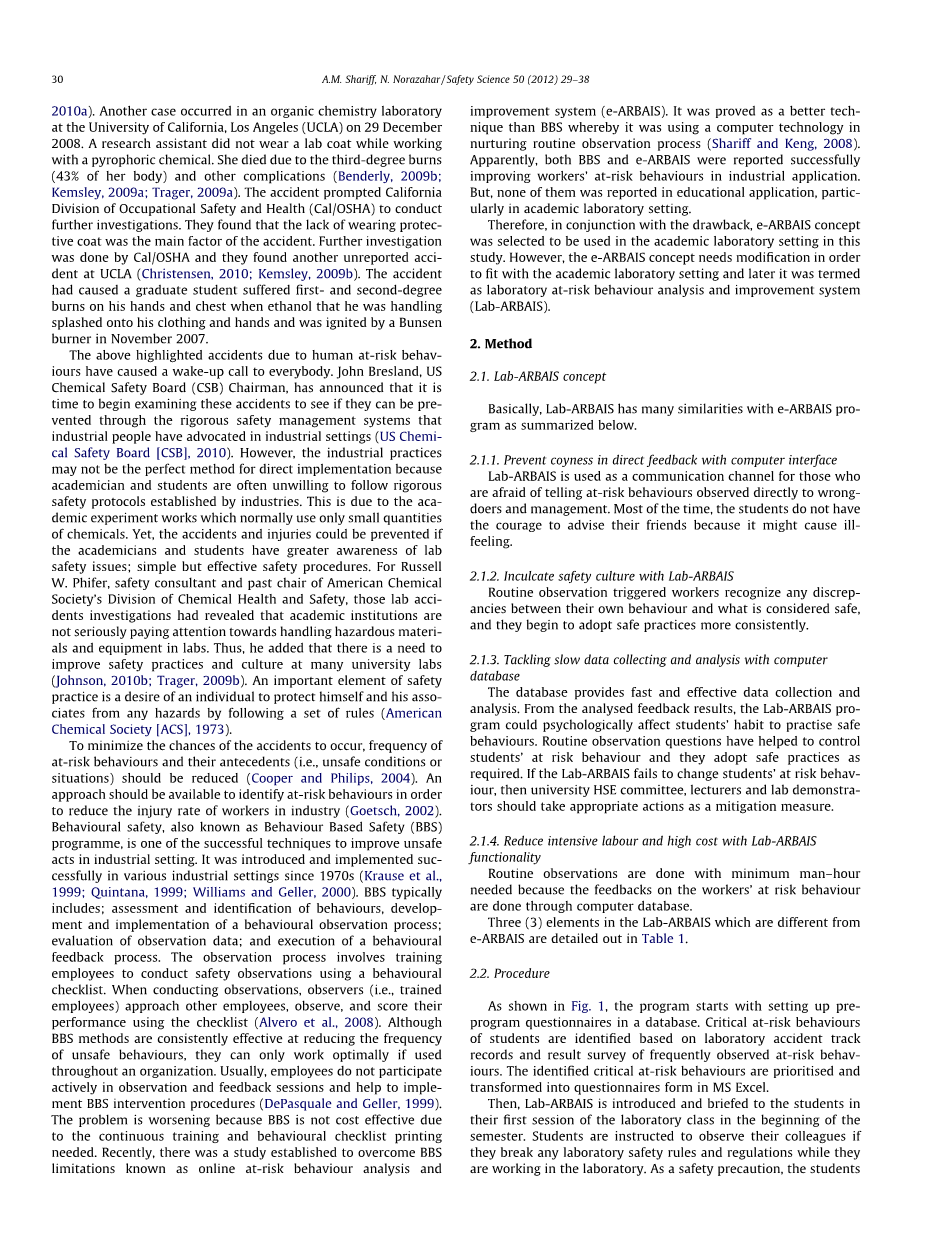

英语原文共 10 页,剩余内容已隐藏,支付完成后下载完整资料
Abstract
Academic laboratories contain inherently substantial risk conditions that students could expose to chemical and physical hazards. Procedures and guidelines related to laboratory safety are commonly available for students to adhere. However, many injuries and accidents or even fatalities are reported due to studentsrsquo; violated safety practices while working in the laboratory. There was no reported proactive method or systematic technique to monitor and control studentsrsquo; at-risk behaviour in the laboratory. This paper presented a program known as laboratory at-risk behaviour and improvement system (Lab-ARBAIS) to monitor and control studentsrsquo; at-risk behaviours in the laboratory. Lab-ARBAIS used computer database for data acquisition and analysis on studentsrsquo; at-risk behaviours observed. Pre-program questions on studentsrsquo; at-risk behaviours that frequently violated safety regulations were utilized by observers to give observation feedback. The collected feedback was analysed and the results were posted in studentsrsquo; portal to allow everyone to acknowledge their safety habits and practices. The routine observations and posted results are to instill a psychology effect in studentrsquo;s habitual safety practices by reminding them on their frequently violated safety regulations. The implementation of the Lab-ARBAIS program to chemical engineering laboratory as a case study had shown a significant improvement on studentsrsquo; frequent at-risk behaviours. The Lab-ARBAIS can easily be adopted in any academic laboratories to manage studentsrsquo; at-risk behaviours to ensure safe work environment. With minor enhancement, the Lab-ARBAIS can easily be extended to be used in industrial laboratories.
Introduction
Most people have a perception that academic laboratory is a safe place for students to work and study. In fact, this perception may not be true since academic laboratory is a serious place of work that safety must be given a priority. Seriousness of academic laboratory safety was highlighted by Langerman (2009), who is a regular columnist for the Journal of Chemical Health and Safety. He had reviewed some of the 94 lab incidents identified by the Chemical Safety and Hazard Investigation Board (CSB) and other incidents recently published in various media and thus, he concluded that most academic laboratories are unsafe venues for work and study. This conclusion is similar to a statement made by Michael J. Halligan, associate director for Environmental Health and Safety at the University of Utah. He said that academic labs have more accidents than industrial labs, but in a smaller scale, because academic labs seldom work with the quantity of materials or scale of processes that are common in industries ( Schulz, 2005). In brief, the lab safety is not given a top priority due to the perception that small quantity of materials would not give a significant hazardous impact to people and environment. It is, therefore, not surprising to know that rate opportunities of lab accident in the schools and colleges is 100–1000 times greater than at Dow or DuPont as estimated by James Kaufman (Benderly, 2009a).
Lab accident is intrinsically linked to studentsrsquo; at-risk behaviours while working in the laboratory (Wu et al., 2007). This problem is worsening because there was no reported technique or implemented system that could be adopted to avoid or minimize the accident and the resulting injuries due to studentsrsquo; at-risk behaviours in the laboratory. The most common prevention practice applied is expecting students to have a business-like attitude all the time in the laboratory by depending on laboratory safety regulations provided by the academic institution. However, the students are often applying the rules only to some situations and not being possible to follow in all operations in the lab. Another factor of breaching the rules is students have the tendency to pride themselves on their inventiveness and curiosity while running experiments in the lab. The rules will always be difficult to fully impose and rely upon because the students have a conflict of interest built into them throughout the years of study (Hale, 1990).
Recently, a few cases of lab accidents and resulting injuries due to studentsrsquo; habitual at-risk behaviours were reported in literature. One of the accidents happened in a chemistry department laboratory at Texas Tech University on January 7, 2010. One student, Preston Brown, 29, was seriously injured on his face and hands when a mixture of nickel hydrazine perchlorate exploded (Johnson, 2010a). Another case occurred in an organic chemistry laboratory at the University of California, Los Angeles (UCLA) on 29 December 2008. A research assistant did not wear a lab coat while working with a pyrophoric chemical. She died due to the third-degree burns (43% of her body) and other complications (Benderly, 2009b, Kemsley, 2009a and Trager, 2009a). The accident prompted California Division of Occupational Safety and Health (Cal/OSHA) to conduct further investigations. They found that the lack of wearing protective coat was the main factor of the accident. Further investigation was done by Cal/OSHA and they found another unreported accident at UCLA (Christensen, 2010 and Kemsley, 2009b). The accident had caused a graduate student suffered first- and second-degree burns on his hands and chest when ethanol that he was handling splashed onto his clothing and hands and was ignited by a Bunsen burner in November 2007。
The above highlighted accidents due to human at-risk behaviours have caused a wake-up call to everybody. John Bresland, US Chemical Safety Board (CSB) Chairman, has announced that it is time to begin examining these accidents to see if they can be prevented through the rigorous safety management systems that industrial people have advocated in industrial settings (US Chemical Safety Board [CSB], 2010). However, the industrial practices may not be the perf
剩余内容已隐藏,支付完成后下载完整资料
资料编号:[148853],资料为PDF文档或Word文档,PDF文档可免费转换为Word
课题毕业论文、开题报告、任务书、外文翻译、程序设计、图纸设计等资料可联系客服协助查找。
您可能感兴趣的文章
- 饮用水微生物群:一个全面的时空研究,以监测巴黎供水系统的水质外文翻译资料
- 步进电机控制和摩擦模型对复杂机械系统精确定位的影响外文翻译资料
- 具有温湿度控制的开式阴极PEM燃料电池性能的提升外文翻译资料
- 警报定时系统对驾驶员行为的影响:调查驾驶员信任的差异以及根据警报定时对警报的响应外文翻译资料
- 门禁系统的零知识认证解决方案外文翻译资料
- 车辆废气及室外环境中悬浮微粒中有机磷的含量—-个案研究外文翻译资料
- ZigBee协议对城市风力涡轮机的无线监控: 支持应用软件和传感器模块外文翻译资料
- ZigBee系统在医疗保健中提供位置信息和传感器数据传输的方案外文翻译资料
- 基于PLC的模糊控制器在污水处理系统中的应用外文翻译资料
- 光伏并联最大功率点跟踪系统独立应用程序外文翻译资料



